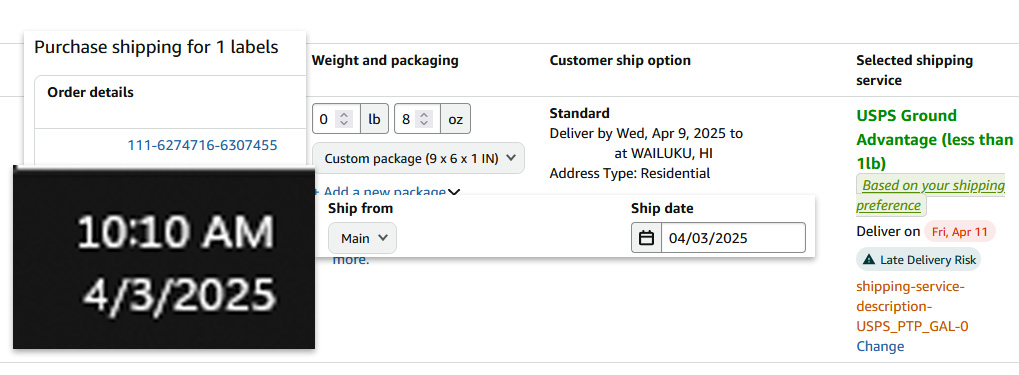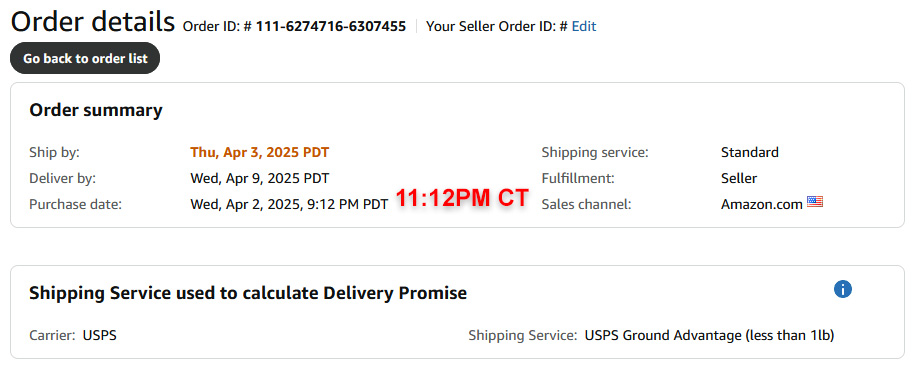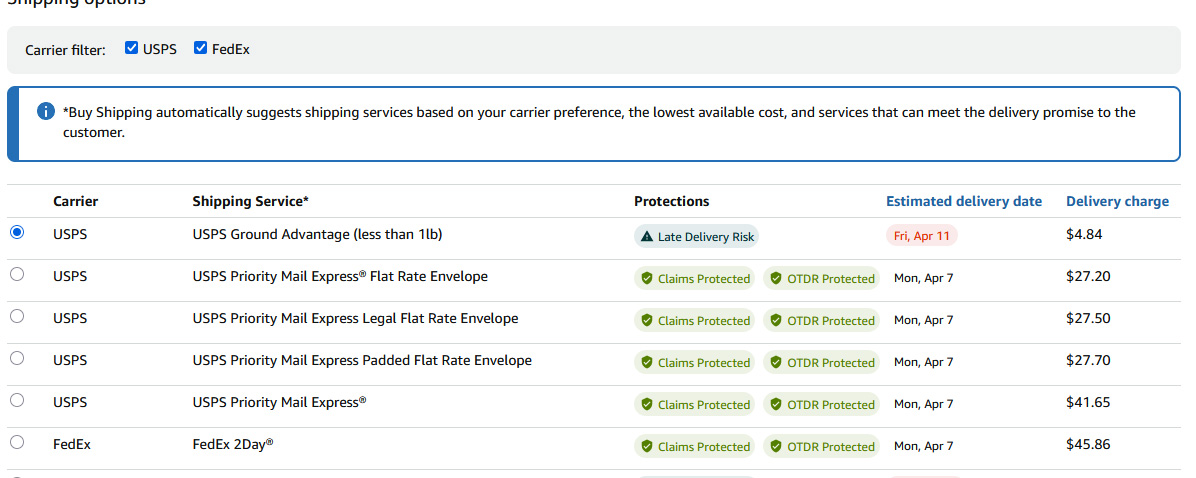In April 2021, Amazon introduced Shipping Settings Automation (SSA), promoting it as the answer to “accurate and automated transit times” that would free sellers from routinely overestimating delivery promises. SSA works by allowing the seller to specify what carriers and shipping methods they prefer, and then to assign those preferred methods to individual products, allowing Amazon to calculate and display more accurate delivery dates to the customer.
Amazon’s own email, shown below, reassured sellers that by enabling SSA and purchasing shipping labels through Amazon Buy Shipping, they could avoid being penalized for carrier-caused delays.
Yet the reality is a bait-and-switch. Sellers, today, who follow these recommendations are still penalized if the carrier delivers late unless they also employ Amazon's latest invention: Automated Handling Time (AHT). In other words, even when Amazon calculates the delivery promise, recommends a shipping method, and labels it “Protected” against late delivery, the seller remains liable for late deliveries if they decline to cede total control of their internal operations to Amazon’s algorithms.
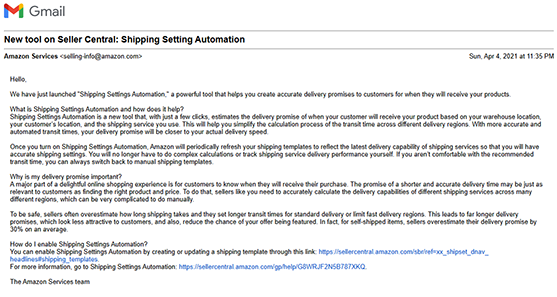
(Amazon's April 2021 Email Announcing SSA)
Automated Handling Time (AHT): Total Control in Exchange for “Protection”
In theory, AHT works by simply requiring sellers to ship orders according to their own historically averaged handling times. For example, if a seller historically shipped an item and manually applied a 2-day handling time, but their actual average handling time was 1.4 business days, AHT will require all such orders to be shipped using a 1-day handling time due to rounding.
And because Amazon requires sellers to ship no more than 4% of shipments later than the seller's promised handling time using a metric named “Late Shipment Rate," this seemingly innocuous system creates a relentless downward pressure on sellers' handling times, who are forced to constantly accelerate their operations to meet Amazon's ever-shrinking handling time mandates, with no upside to shipping faster than planned. Taken together, the "Late Shipment Rate" metric and "Automated Handling Time" tool create an inescapable cycle: faster shipping leads to even faster required handling times, potentially pushing sellers towards same-day shipping for all products, regardless of logistical feasibility. Sellers on AHT cannot adjust handling times for individual items for any reason without disabling AHT completely and thus losing all protection. Do extreme weather conditions require a longer handling time window for sensitive items during the winter or summer months? These common-sense business decisions become impossible after enabling AHT.
The oppressive, deceptive, and fundamentally indefensible nature of Amazon's policies are best illustrated through a simple comparison. Imagine two businesses, practically identical in every way. They sell the same product to the same customer. Both diligently utilize Amazon's recommended tools: Shipping Settings Automation (SSA) to allow Amazon to estimate an accurate delivery promise based on the seller’s preferred methods, and Amazon Buy Shipping, to ensure that the customer’s address is copied to the shipping label as entered by the customer. Both ensure their packages are scanned by the carrier on time, meeting the initial "Ship By" deadline.
One business, however, has adopted Automated Handling Time (AHT), with Amazon mandating a 2-day handling time based on the business’s historical shipping times. The other business, choosing to retain control over its operations, has manually set a 2-day handling time, matching the requirement imposed on the business utilizing AHT.
Now, due to a carrier delay—a factor outside the control of either seller—both shipments arrive late to their respective customers.
The Result:
The business using AHT is protected from all penalties; their On-Time Delivery Rate (OTDR) is unaffected.
In contrast, the business that manually set their handling time, despite adhering to the same 2-day timeframe and all other requirements, is penalized; their OTDR takes a hit.
The Inequity:
Both businesses followed the same timeline. Both relied on the same Amazon-approved carrier. Both experienced the same carrier delay. Yet, only the business that surrendered its operational autonomy to Amazon's algorithm is shielded from the consequences. This stark disparity highlights the core injustice: Amazon's policies punish sellers for retaining control over their own businesses, even when they meet or exceed the same performance standards as those who relinquish that control. This outcome is neither about efficiency nor customer satisfaction; it's about enforcing compliance with Amazon's systems, regardless of the actual circumstances or the seller's adherence to their own promised handling times or other written policies.
The Paradox: Amazon Dictates, Yet Amazon Blames
Here lies the injustice:
- Amazon calculates the delivery promise and sets the “Ship By” date.
- The seller abides by these instructions, selects the “OTDR Protected” carrier service by purchasing a shipping label within Amazon, and ships on time.
- A carrier delay occurs outside the seller’s control.
- Amazon penalizes the seller’s OTDR metric unless the seller had also surrendered to AHT.
It is a Catch-22: either relinquish fundamental control of one’s business to Amazon’s fleeting metrics or risk losing the privilege to sell on Amazon if 10% or more of deliveries arrive late over a mere two-week span—even when the seller did everything Amazon required other than enabling "Automated Handling Times."
The “OTDR Protected” Badge: A Deceptive Illusion
Amazon compounds this injustice by displaying a green icon bearing the words “OTDR Protected” onto orders, complete with a symbol of a shield to infer protection, and a check-mark to imply eligibility—suggesting safe harbor from late-delivery penalties. Only upon hovering over this icon with a mouse in a computer browser is hidden text displayed, which stipulates that a trifecta of requirements (SSA, AHT, and a timely first scan by the carrier) must all be met in order for this "OTDR Protected" order to actually, in-fact, be protected from late delivery penalties. Further, no official report confirms whether an order truly met these criteria. Many sellers discover too late that, despite believing they were “protected,” they have been penalized for incomplete compliance.
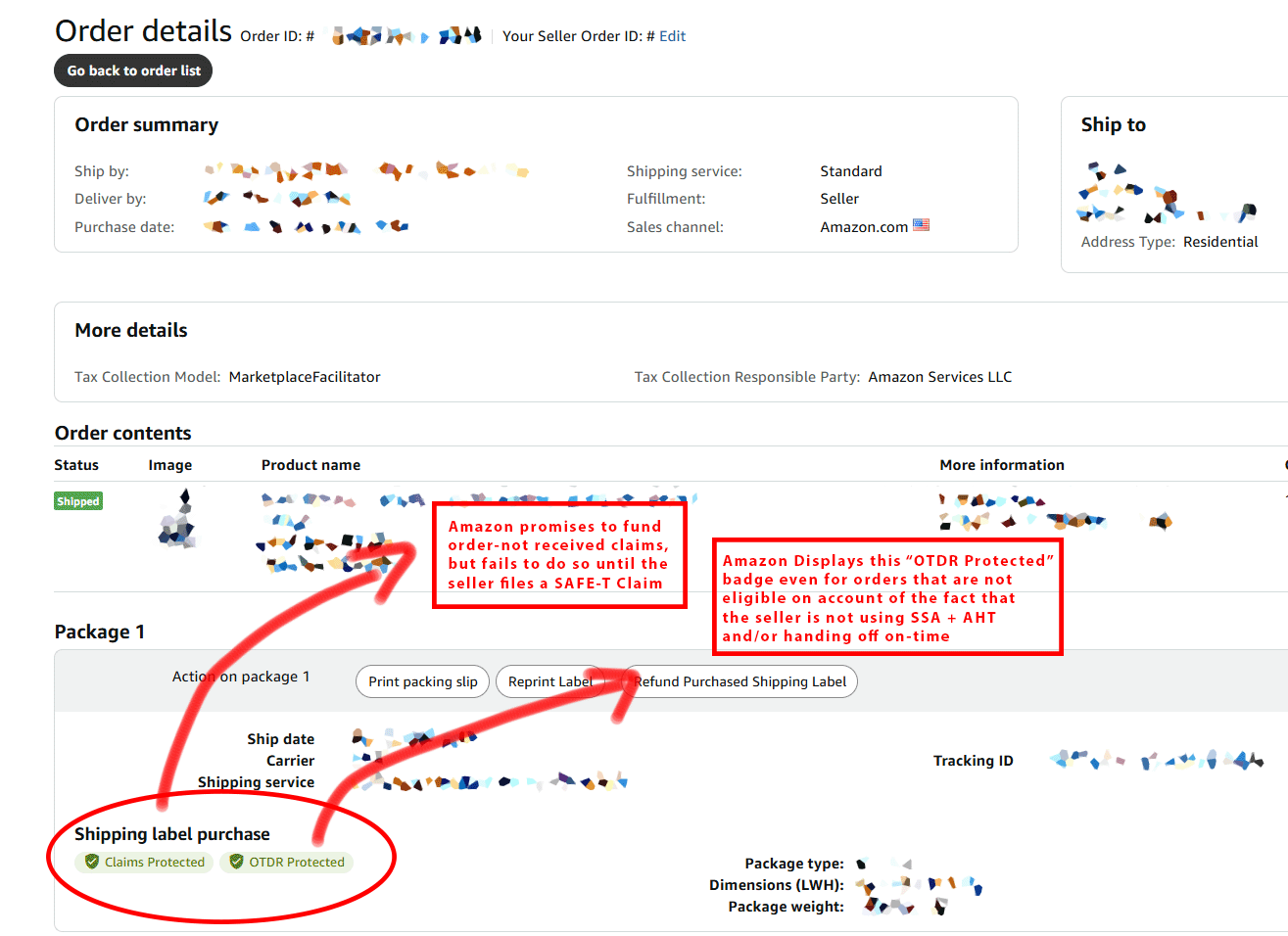
(Typical order detail page displaying "OTDR Protected" badge)
Monthly Emails: Punishing Both Late and Early Deliveries
Amazon’s stance grows even more contradictory when it discourages sellers to deliver earlier than promised. Sellers who improve their processing times or manually add extra shipping days to delivery estimates, either to delight customers or to avoid Amazon's punitive On-Time Delivery policies receive “Monthly Update: You have a Delivery Promise Gap” emails, in which Amazon warns that "customers [who] see longer and less attractive delivery dates are less likely to buy," and that employing Amazon's tools like SSA can help grow sales. Thus, sellers are pressured not to exceed the system’s predictions while simultaneously being penalized for any tardiness. It is a no-win scenario that crushes independent decision-making.
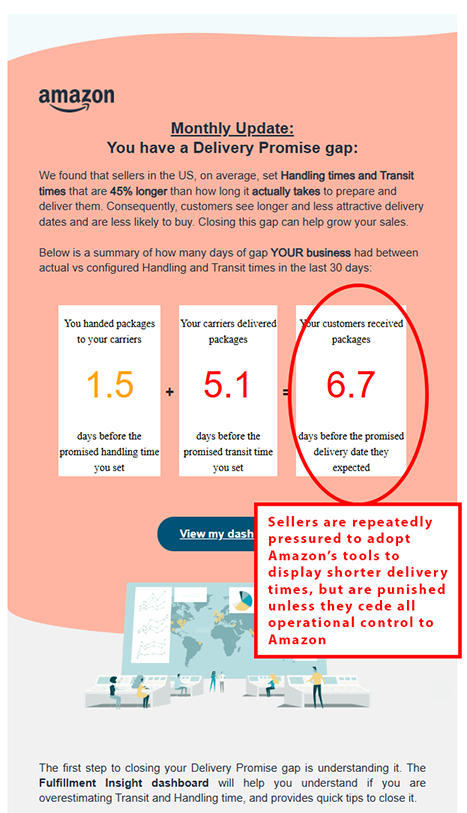
(Example email from Amazon with subject line: "Monthly Update: You have a Delivery Promise gap")
Undermining Livelihoods, Weaponizing Metrics
Countless small businesses have spent years, decades in some cases, cultivating loyal audiences on Amazon and relying on the marketplace’s promise of fair policies and robust buyer traffic. Today, Amazon’s labyrinthine shipping rules strip sellers of the autonomy presumed by any independently owned and operated small business. By holding the On-Time Delivery Rate metric hostage to both SSA and AHT as a weapon for total compliance, Amazon effectively gives sellers an ultimatum: “Relinquish total control over your fulfillment promises, or face the perpetual threat of account suspension for inevitable carrier delays.” This asymmetrical dynamic places sellers in a lose-lose bind that undermines the principles of a free marketplace and violates the trust they once placed in Amazon.

Conclusion: A Call for Fairness and Transparency
In light of these facts, it is clear that Amazon is abusing its market dominance to unilaterally impose rapidly evolving policies and operating procedures to contracts of adhesion for the purpose of coercing independently operated businesses into relinquishing total operational control under the guise of “protection”—all while refusing to acknowledge carrier-related realities that are plainly beyond a seller’s power to control for sellers who only partially utilize Amazon's tools. The “OTDR Protected” badge which is prominently displayed both when purchasing a shipping label and permanently attached to order detail pages is a prime example of misleading communication, leaving many helplessly guessing which hidden criteria might still fail them.
Sellers deserve transparency and genuine protection from carrier mishaps when they ship on-time using an Amazon-approved method, without other arbitrary conditions. Instead, they face a system that punishes them for trusting the very delivery estimates Amazon prescribes. For entrepreneurs who entrusted Amazon to enable rather than endanger their livelihood, this is a deep affront to the freedom and independence every small business holds dear.
Key Action Points:
To rectify these injustices and foster a truly equitable marketplace, Amazon should adopt the following changes to its policies and practices:
1. Revise the On-Time Delivery Rate (OTDR) Policy:
Core Principle: OTDR protection should be granted based on seller actions within their control, not on coerced adoption of automation tools.
Specific Action: Amazon must revise its OTDR policy to automatically protect orders meeting the following criteria:
A) Shipping Label Purchase: The seller purchases a shipping label through Amazon Buy Shipping (or a similarly integrated platform) AND selects a shipping method that Amazon's system deems capable of achieving on-time delivery.
B) Timely Carrier Scan: The carrier's first scan of the package occurs on or before the "Ship By" date, as determined by the seller's stated handling time.
Crucially: Neither Shipping Settings Automation (SSA) nor Automated Handling Time (AHT) should be required for OTDR protection.
2. Eliminate the Deceptive "OTDR Protected" Badge:
Core Principle: Transparency and honesty are paramount. Misleading visual cues erode trust and create confusion.
Specific Action: Amazon must immediately cease displaying the "OTDR Protected" badge on any order that does not meet all current and any revised "OTDR Protected" eligibility requirements. The current badge design and its placement are misleading and should be removed entirely if protection is not guaranteed.
3. Provide Complete and Transparent OTDR Data:
Core Principle: Sellers need comprehensive data to make informed decisions and manage their businesses effectively.
Specific Action: Amazon must ensure the OTDR defect report includes every possible reason why an order might not be considered OTDR protected. This includes, but is not limited to, specific details regarding SSA, AHT, carrier scan status, and any other relevant factors. Without full access to this data, sellers are left unable to understand or address potential issues proactively. This transparency is critical for responsible business operations. These changes will make this easier on Amazon sellers and promote a better business environment.
